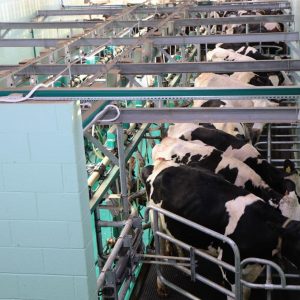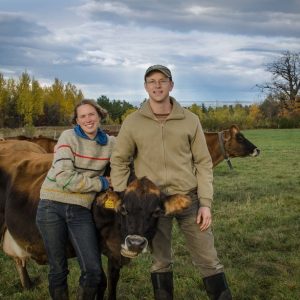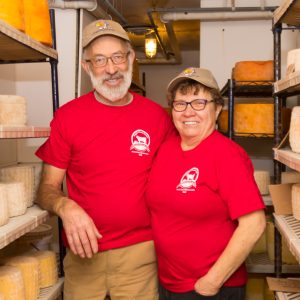This April, shoppers throughout the country faced empty milk shelves in their grocery stores, while at the same time, North Country dairy farmers dumped tens of thousands of gallons of their herds’ daily production down the drain.
Why did this happen? Why are farmers dumping milk when store shelves just a few miles away are empty?
The problem is a food supply chain — the network of people, places, and processes that move food from farms to tables — that trades resilience and security for efficiency and profit. Like other agricultural products, the dairy supply chain has been made dependent on large-scale centralization and operation — consolidation that does not financially benefit farmers. When the system works, as it does much of the time, it’s invisible to most people. But the pandemic has shown all of us with brutal clarity how vulnerable our national food system is to disruption.
In a forthcoming series of posts we will examine the supply chains for dairy, meat, and vegetables, analyze the problems that big, centralized supply chains present, and discuss what relocalizing supply chains might look like, as well as the benefits that the process would bring to the security and resilience of local food systems.

We’ll start here with dairy. But before we unpack the dairy supply chain and its problems, it is important that we define some terms. Take resilience, for example, which has become something of a buzzword among development professionals. At ANCA we define resilience as the ability to adapt to negative impacts without long-term or severe disruption. Resilient systems are redundant and difficult to break: resilience leads to security. A secure food system is one that is always able to meet the food needs of all members of a particular population.
One of the best ways to make our food system resilient and secure is to relocalize it, which is the process of returning production and distribution of food to a local scale. This isn’t something new; in the fairly recent past most food was produced and sold locally. And we have a choice going forward: do we go back to “normal” or can we relocalize and rescale parts of the food supply chain in ways that will benefit farmers, retailers, and consumers?
What might this look like for the dairy supply chain? Milk is a challenging product to produce and distribute because it is so perishable. Farmers must quickly chill the product after milking and get it to a processing plant within 48 hours.
There are two basic streams in the supply chain for milk, Grade A and Grade B. Grade A milk is sold as fluid milk, while Grade B is destined for further processing into products like cheese, butter, and yogurt. Demand for fluid milk in the U.S. has undergone a steady decline over the last two decades, so a lot of Grade A milk is now getting processed into cheese and butter.
Restaurants and schools account for a large portion of dairy sales — especially cheese and butter — and the loss of those sales during pandemic-related shutdowns has led to temporary plant closures, which means farmers have lost places to bring their milk for processing. Some plants process and pack dairy products at a scale that makes it impossible for them to pivot to retail-scaled production — making and packaging 8-ounce instead of 10-pound blocks of cheese for example. At the same time, fluid milk plants are operating at full capacity and can’t take on additional Grade A milk to process. It is this set of circumstances that creates the contradiction of dumping thousands of gallons of milk while store shelves are barren.
An answer to this problem is to move towards less centralized, more local, smaller scale milk processing. In the North Country, some folks are already working towards this goal. Black River Valley Natural is a small creamery in Lyons Falls, NY that is looking to expand its production capacity. They make their own products and also co-pack for other dairy producers. During the pandemic, Black River Valley Natural started buying milk from three local dairy farms. They are running at full capacity and selling out of milk daily. Their expansion plans will help them to better serve the region by providing fluid milk in half and whole gallons to schools that are making daily food deliveries to district families, and to individuals.


In Hudson Falls, NY, Argyle Cheese Farmer, a 2019 ANCA Local Farm Challenge Grant recipient, opened a new retail location on April 25th in the front section of the 10,000 square foot building they purchased this winter. They are in the process of refitting the remainder of the building to house an expanded processing area because they maxing out their capacity at
their plant in Argyle. They make a variety of cheeses, dips, traditional and Greek yogurt, and buttermilk. The milk comes from Ideal Dairy Farm, their neighbor just three miles from the new site. Sales have been so good that
they have already expanded their hours, showing clearly that there is a strong market for local dairy.
What if there were more options like these for milk processing? There are always going to be big dairy plants; we need those to process milk at the wholesale scale. But what might our supply chain look like if there was a network of smaller-scale processors to complement the big plants? It is likely that there will be further disruptions to our food supply chain — from pathogens, catastrophic weather events, or other adversities. Additional small-scale dairy processing facilities could build redundancy into the system — bolstering the resilience and security of the local food supply chain — and could help to avoid the heartbreaking situations we have recently seen where farmers are faced with no choice but to destroy perfectly good food while people go hungry.
Note: Last, but certainly not least, is the network of small-scale, artisan dairy producers in the Adirondacks. Sugar House Creamery and Blue Pepper Farm in Jay, Asgaard Farm in AuSable Forks, and North Country Creamery in Keeseville are all producing world-class cheese, yogurt, and raw milk from their herds of sheep, goats, and cows. Their products can be purchased at a number of local stores and grocers, regional farmer’s markets and their own farm stores.
Stay tuned for more in this series of blog posts for 2020, where we examine food supply chains in different agricultural sectors.
Photo 1: The U.S. dairy industry has become dependent on large-scale centralization and operation.
Photo 2: Dave and Marge Randles of Argyle Cheese Farmer in Hudson Falls
Photo 3: Ashlee Kleinhammer and Steven Googin of North Country Creamery in Keeseville
